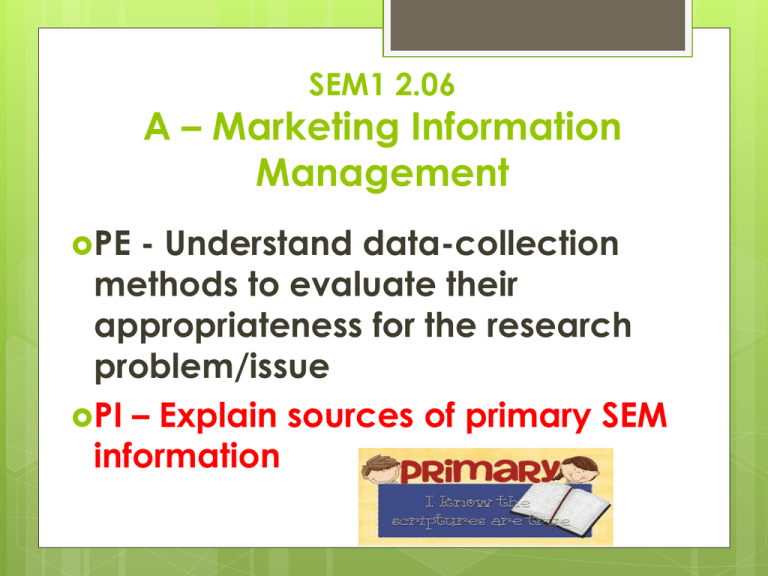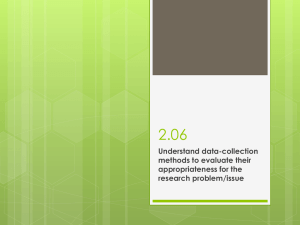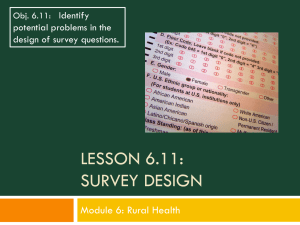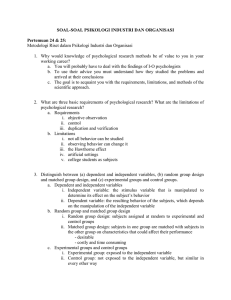SEM1 2.06
advertisement

SEM1 2.06 A – Marketing Information Management PE - Understand data-collection methods to evaluate their appropriateness for the research problem/issue PI – Explain sources of primary SEM information Review – Primary & Secondary MIM Primary Data: Data obtained for the first time and used specifically for the particular problem or issue under study Secondary Data: Data that has already been collected for some purpose other than the current study It is most effective for companies to decide what secondary data it will use before collecting primary data. But if you do not get good results, try primary So how do you collect primary data? See the following Survey method for Primary Data •Survey •A research technique in which information is gathered from people through the use of surveys or questionnaires. •Surveyors usually use a sample of the entire target population to get results Pros: Cons Data Low can be quantified Accurate sample size Able to ask many questions participation rate Feedback is limited Types of Surveys Personal interview – involves questioning people face-toface. Often conducted in central locations. Advantage: People are likely to respond. Disadvantage: Costly Focus group interview- involves eight to twelve people who are brought together to evaluate a product, design, or strategy under the direction of a skilled moderator http://www.youtube.com/watch?v=pcj7QT0Abk8 Telephone interview – quick, efficient, and relatively inexpensive. Disadvantage: some people are unwilling to participate Mail survey – relatively inexpensive way to reach a large audience. Respondents are generally honest and find this type of survey less intrusive. Disadvantage: return rate for mail surveys is less than 5% - 10%. Internet survey – includes wide-open polls, anybodycan-answer polls, invitation-only surveys, password protected research sites, and Internet – based panels. Observation method for Primary Data Observation method – a research technique in which the actions of people are watched and recorded either by cameras or observers. Mystery shopper – a researcher who poses as a customer http://www.youtube.com/watch?v=EfdW6mgBEG0 Point-of-sale research – a research technique that combines natural observation with personal interviews to get people to explain buying behavior Focus groups Pros: •Gauge consumer reaction •Monitor group reaction Cons: •Susceptible to leader’s biases •Small sample size & expensive Experimental method for Primary Data Experimental method A research technique in which a researcher observes the results of changing one or more marketing variables while keeping certain other variables constant under controlled conditions. Often used to test new package designs, media usage, and new promotions. http://www.youtube.com/watch?v=4NK_jGglELI •Pros - Can be performed in actual settings •Participants not aware of monitoring so natural reactions •Cons - Sample is small and hard to control •Interpretation of data may be difficult The marketing survey Why? Businesses need valid and reliable data to make good decisions. But, marketing researchers need to know how to construct survey instruments that provide the necessary information to assist in the decisionmaking process. But they must have: Reliability – exists when a research technique produces nearly identical results in repeated trials. Validity- exists when the questions asked measure what was intended to be measured The marketing survey Types of questions used in surveys Open-ended questions ask respondents to construct their own response to a question. Example: “How can we serve you better?” http://www.youtube.com/watch?v=8GA2hlleuA8 Forced-choice questions ask respondents to choose answers from possibilities given. These are the simplest questions to write and the easiest to tabulate. Types of forced-choice questions are as follows: The marketing survey Forced-choice questions Yes/No Questions: Only gives two options, should only be used when asking for a response on one issue. Multiple-choice Questions: Gives the respondent several choices, important that the options are made comprehensive enough to include every possible response. Usually includes an “other” option. Rating Scale Questions: Variety of questions used such as very satisfied to very dissatisfied, or excellent to poor. Level of Agreement Questions: Used to assess attitudes or opinions. Commonly used options: strongly agree (SA), agree (A), neutral (N), disagree (D), and strongly disagree (SD). The marketing survey Basic guidelines for writing questions: Should be written clearly Should be as brief as possible Do not ask leading questions which suggest a correct answer Avoid bias Avoid questions that might cause a respondent to guess at the meaning of your question. Pretest – allows for correction of any misleading questions, directions, or problems The marketing survey Formatting Surveys Need excellent visual appearance and design to appeal to respondents. Use dark ink on light paper (Contrast) Use type that is easy to read Shade sections for contrast Use arrows to lead the reader Use section headers or numbers on individual survey sections Number the questions Directions for completion must be clear Use a variety of question types (All answers should not be yes) Group demographic questions about gender, age, ethnic background, and education, etc. at the end of the questionnaire.











